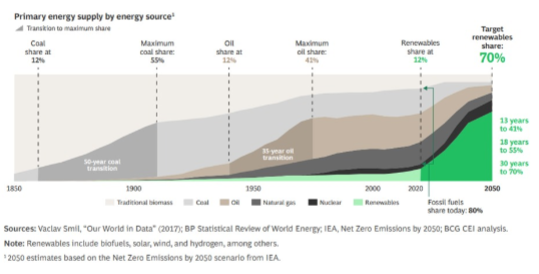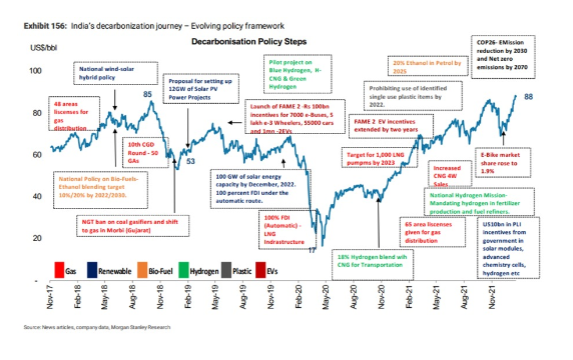Clean Energy with Rapid Strides & A Perspective!!!
- Vikram Kotak
During my recent visit to London, I was amazed to see so many high-end electric cars including Porsche, BMW, and Mercedes, needless to say, Tesla is dominating the roads. I was truly impressed with the charging infrastructure in the city, almost every second poll has a charging station. The car can be charged in 30-40 minutes and can give 350-400 miles of running.
I understand the USA is also leading a big transformation in renewables. A profound shift is taking place that is nearly invisible to most Americans. For example, delivery vans in Pittsburgh, buses in Milwaukee, cranes loading freight at Los Angeles port, and every municipal building in Houston, all are powered by electricity derived from the sun, wind, or other sources of clean energy.
The nation that burned coal, oil, and gas for more than a century to become the richest economy on the planet, as well as historically the most polluting, is rapidly shifting away from fossil fuels.
A similar energy transition is already well underway in Europe and elsewhere. But the USA is surely in the fast lane, and the change is happening at a pace that is surprising even the experts who track it closely.
If we go by this report by BP, BCG, IEA, etc., from 12% in 2020, the renewable energy share will be 70% by 2050. This will be of course at the cost of coal and oil as presented herein below.

Further, wind and solar power are breaking records, and renewables are now expected to overtake by 2025 as the world's largest source of electricity. Automakers have made electric vehicles central to their business strategies and are openly talking about an expiration date on the internal combustion engine. Heating, cooling, cooking, and some manufacturing are going electric.
The overall cost of generating electricity from the renewable sources has come down significantly. Private investment is flooding into companies that are jockeying for advantage in emerging green industries.
China, which already leads the world in the sheer amount of electricity produced by wind and solar power, is expected to double its capacity by 2025, five years ahead of schedule. In Britain, roughly one-third of electricity is generated by wind, solar, and hydropower. And in the USA, 23 percent of electricity is expected to come from renewable sources this year, up 10 percentage points from a decade ago.
But at the same time when I read another piece of news, it surprises me more. A new Panasonic factory for manufacturing EV battery is coming up at a massive investment of US$ 4 bn in Kansas USA. This factory will consume anywhere between 225-250 MW of electricity to function. This is equal to the power demand of lighting up a small city. News summarizes that in order to create clean energy you have to burn a lot of dirty energy rendering it to a pointless endeavour. I am not an expert in this subject but if these numbers are true then it raises questions about which one of the two energy sources is better.
In aggregate, the impact of this EV transformation could be revolutionary; one study estimates that global carbon dioxide emissions could fall by 1.5 gigatons per year if half of the world's cars were electric. But the EV revolution comes with its own dirty cost. The materials that go into today's batteries, such as nickel, lithium, and cobalt, are in extreme demand. Prices for these minerals are soaring. For the countries in which these elements are buried, the EV boom promises profits.
But it also means massive extraction efforts — and the environmental and social issues that this may cause. In Chile, huge evaporation pools draw lithium out of the salt flats of the Atacama Desert, spawning arguments over water use and the rights of indigenous people. In Congo, cobalt-mining operations blast the earth with such disruption that locals are forced to relocate. In Indonesia, the scramble for nickel has never been more urgent.
China, who has pledged to be carbon neutral by 2060 and will need almost 90% of its vehicles to be fully electric by 2035. To meet its target, China now dominates mining activities for EV battery materials in these countries. But the extraction leaves deep scars on the landscape.
In China, which is currently both the world's top polluter and the global leader for renewable power, the government continues to invest in every stage of clean energy production, from solar cells to batteries, wind turbines, and more. Like the United States, China provides subsidies to buyers of electric vehicles. Last year it spent US$ 546 bn on clean energy, far more than any other country in the world.
With costs falling fast, manufacturing has picked up and installations of solar and wind projects have increased. The USA solar industry installed a record 6.1 GW of capacity in the first quarter of 2023, a 47% increase over the same period last year. These low costs have led many of the USA's biggest corporations, such as Alphabet, Amazon, and General Motors, to purchase large amounts of wind and solar power, because it amplifies their reputations and makes good economic sense.
Coming to India, we too have made good progress in renewable energy, in fact we were among the early ones to create good capacity in Hydropower. A series of interventions and policy frameworks are rolled out in support to reduce the carbon footprint. It can be seen from the chart here that there are concerted efforts taken by India to promote renewable energy, gas, biofuels, etc.

We still surely have a long way to go. India is facing many challenges such as off-taker risk, lack of infrastructure, lack of financial intermediaries, and lack of investor understanding. These apart, we also need to pull up in areas such as managing decisions to deliver, financial incentives, and proper implementation of private and public sector models. Large local investments from the private sector and money flow from foreign firms will be a key focus area for India.
There is no looking back, clean energy-based future has to be embraced, keeping environment and social issues in mind. Let me sum up with one of the best quotes by Steven Chu, “As the saying goes, the Stone Age did not end because we ran out of stones; we transitioned to better solutions. The same opportunity lies before us with energy efficiency and clean energy.”